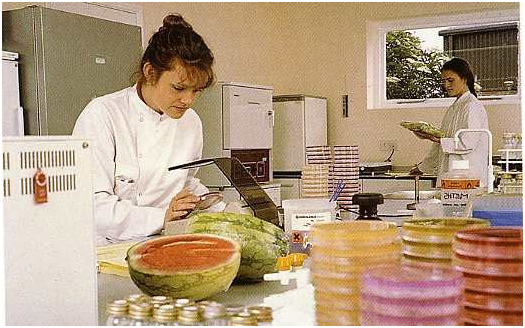Intrinsic factors of food spoilage are those inherent factors that are associated with the food and which in several ways affect the overall physical and chemical composition of the food. Intrinsic factors are food related factors; and they are generally referred to as the physico-chemical properties of food. The composition of a particular food is a significant factor in the spoilage of that particular food or food product. These intrinsic factors of food spoilage include the nutrient makeup of the food, the acidity or alkalinity of the food, water activity, moisture content, buffering capacity and the pH of the food.
Some food or food products also contain antimicrobial agents as intrinsic factors; and these antimicrobial constituents and the aforementioned intrinsic factors play several roles in the spoilage of food. It is noteworthy that low pH favours the growth of fungi particularly yeasts and moulds; and foods with high moisture content favour the growth of food spoilage organisms than foods with low moisture content. Production of odours or offensive smell is usually associated with foods with high protein content; and such foods or food products undergo putrefaction.
Putrefaction is the microbial decomposition of organic matter (such as the anaerobic breakdown of proteins) with the production of foul-smelling compounds. Amines and hydrogen sulphide are typical examples of some foul-smelling compounds produced in the microbial degradation or decomposition of food or food products with high protein content. Food or food products with high fat content are usually rendered rancid due to the production of short-chain fatty acids from fats by lipophilic or lipolytic microbes (e.g. bacteria).
Rancidity is defined as a type of food spoilage that occurs in food or food products with high lipid content; and it is mainly characterized by the production of fatty acids. It is worthy of note that foods with high salt and sugar content prevent the growth of some food spoilage organisms. Nevertheless, osmophilic and xerophilic organisms can still grow under high salt and sugar concentration. Osmophilic organisms are organisms that have the ability to grow in environment with very high concentration of solutes such as sugar and salt. They can also be known as osmophiles. Xerophilic organisms or xerophiles are organisms that have the ability to grow in environment with low water activity (aW).
Xerophiles thrive very well in food or food products with little or no water activity; and such organisms are responsible for the spoilage of foods with low moisture content. Since microorganisms are ubiquitous and they play critical roles in the processing or production of food, and in the handling and distribution of food and food products; it is important to ensure proper food storage in order to the prevent food spoilage due to microbial activity.
References
Bushell M.E (1998). Application of the principles of industrial microbiology to biotechnology (ed. Wiseman, A.) Chapman and Hall, New York.
Byong H. Lee (2015). Fundamentals of Food Biotechnology. Second edition. Wiley-Blackwell, New Jersey, United States.
Clark D.P and Pazdernik N (2010). Biotechnology. First edition. Elsevier Science and Technology Books, Amsterdam, Netherlands.
Farida A.A (2012). Dairy Microbiology. First edition. Random Publications. New Delhi, India.
Frazier W.C, Westhoff D.C and Vanitha N.M (2014). Food Microbiology. Fifth edition. McGraw-Hill Education (India) Private Limited, New Delhi, India.
Guidebook for the preparation of HACCP plans (1999). Washington, DC, United States Department of Agriculture Food Safety and Inspection Service. Accessed on 20th February, 2015 from: http://www.fsis.usda.gov
Hayes P.R, Forsythe S.J (1999). Food Hygiene, Microbiology and HACCP. 3rd edition. Elsevier Science, London.
Hussaini Anthony Makun (2013). Mycotoxin and food safety in developing countries. InTech Publishers, Rijeka, Croatia. Pp. 77-100.
Jay J.M (2005). Modern Food Microbiology. Fourth edition. Chapman and Hall Inc, New York, USA.
Lightfoot N.F and Maier E.A (1998). Microbiological Analysis of Food and Water. Guidelines for Quality Assurance. Elsevier, Amsterdam.
Nduka Okafor (2007). Modern industrial microbiology and biotechnology. First edition. Science Publishers, New Hampshire, USA.
Roberts D and Greenwood M (2003). Practical Food Microbiology. Third edition. Blackwell publishing Inc, USA.
Discover more from #1 Microbiology Resource Hub
Subscribe to get the latest posts to your email.



